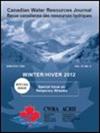评估未来灌溉储水需求的新模型范例:艾伯塔省西部灌区的案例研究
IF 0.9
4区 环境科学与生态学
Q3 WATER RESOURCES
引用次数: 3
摘要
摘要自20世纪80年代初以来,阿尔伯塔省的流域规划一直依赖于计算机建模。典型的建模研究依赖于单时间步长操作框架,在该框架中,水分配决策是针对单个模型时间步长做出的,而没有考虑季节性预测或农业社区通常实施的相应需求对冲规则。这种建模通常会导致干旱年份水库蓄水量过早耗尽,产生的模型结果比灌溉者使用经验法则做出的决策更糟糕。本文批判性地回顾了当前的建模实践,并通过使用多时间步长优化与最优需求对冲相结合,深入了解了建模中可能的改进,这是模型解决方案的一部分。案例研究的重点是阿尔伯塔省南部西部灌溉区潜在的蓄水量扩展。多时间步长优化方法的改进也为过去做出的重要水管理决策以及灌溉失效标准修订定义的价值提供了新的线索。最后,选定的建模方法揭示了与未来基础设施发展相关的资本成本节约的巨大潜力,并表明投资于数字基础设施——更好的预测和水库管理工具——可能比投资于额外的物理基础设施更具生产力。本文章由计算机程序翻译,如有差异,请以英文原文为准。
New modeling paradigms for assessing future irrigation storage requirements: a case study of the Western irrigation district in Alberta
Abstract River basin planning in Alberta has relied on the use of computer modeling since the early 1980s. Typical modeling studies rely on a single time step operational framework, where water allocation decisions are made for individual model time steps, without taking into account seasonal forecasts or the corresponding demand hedging rules that are often implemented by farming communities. This kind of modeling often leads to premature depletion of reservoir storage during dry years, producing model results that represent worse decisions than those that irrigators would make by using the rule-of-thumb. This paper critically reviews the current modeling practice, and provides insight into possible improvements in modeling through the use of multiple time step optimization in combination with optimal demand hedging, which is found as part of the model solution. A case study focuses on potential storage expansions in the Western Irrigation District of Southern Alberta. Improvements with the multiple time step optimization approach also shed new light on important water management decisions made in the past and the value of a revised definition of irrigation failure criteria. Finally, the selected modeling approach reveals significant potential for capital cost savings related to future infrastructure development, and suggests that investing in digital infrastructure – better forecasting and reservoir management tools – may be more productive than investment in additional physical infrastructure.
求助全文
通过发布文献求助,成功后即可免费获取论文全文。
去求助
来源期刊

Canadian Water Resources Journal
WATER RESOURCES-
CiteScore
2.90
自引率
5.90%
发文量
17
审稿时长
>12 weeks
期刊介绍:
The Canadian Water Resources Journal accepts manuscripts in English or French and publishes abstracts in both official languages. Preference is given to manuscripts focusing on science and policy aspects of Canadian water management. Specifically, manuscripts should stimulate public awareness and understanding of Canada''s water resources, encourage recognition of the high priority of water as a resource, and provide new or increased knowledge on some aspect of Canada''s water.
The Canadian Water Resources Journal was first published in the fall of 1976 and it has grown in stature to be recognized as a quality and important publication in the water resources field.
 求助内容:
求助内容: 应助结果提醒方式:
应助结果提醒方式:


